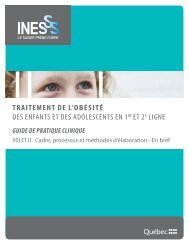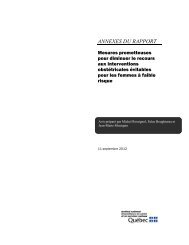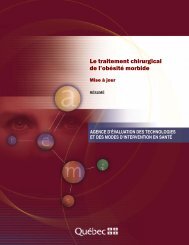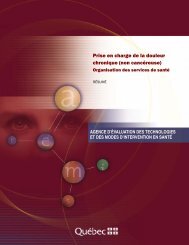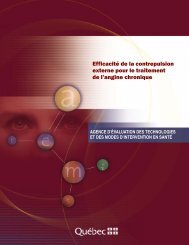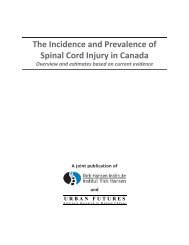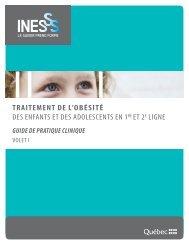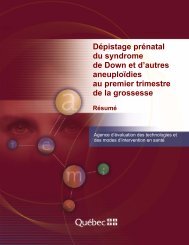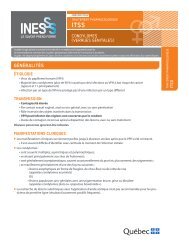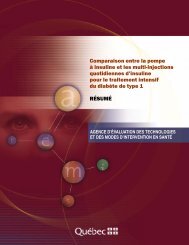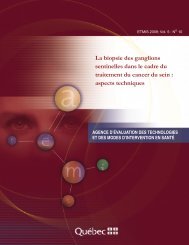Traitement du cancer de l'Åsophage : revue systématique ... - INESSS
Traitement du cancer de l'Åsophage : revue systématique ... - INESSS
Traitement du cancer de l'Åsophage : revue systématique ... - INESSS
You also want an ePaper? Increase the reach of your titles
YUMPU automatically turns print PDFs into web optimized ePapers that Google loves.
Results<br />
The specific characteristics of esophageal <strong>cancer</strong><br />
(low inci<strong>de</strong>nce and rapid progression) make it<br />
difficult to recruit study patients. The selected<br />
studies did not have sufficient statistical power<br />
to <strong>de</strong>tect a difference between the two surgical<br />
treatment groups in terms of primary and secondary<br />
endpoints. A non-significant result may indicate<br />
that the studies were unable to show a difference,<br />
and not that the proce<strong>du</strong>res are equivalent.<br />
The heterogeneity of tumour characteristics<br />
(histological type, location, stage) and of patient<br />
clinical characteristics, the different surgical<br />
techniques proposed and the lack of standardization<br />
of these techniques do not make it possible to<br />
con<strong>du</strong>ct controlled studies of high methodological<br />
quality. Few RCTs have been published on the<br />
topic, and most of the studies are non-randomized<br />
and retrospective, and compare patient groups that<br />
are generally non-equivalent. As a result, studies<br />
of poor and average methodological quality were<br />
selected, and their results must be interpreted with<br />
caution.<br />
Transthoracic vs transhiatal technique<br />
In general, the studies yiel<strong>de</strong>d similar postoperative<br />
mortality rates among the patients with esophageal<br />
<strong>cancer</strong> who un<strong>de</strong>rwent transthoracic or transhiatal<br />
esophagectomies. Furthermore, for patient<br />
subgroups, the results of a few studies showed the<br />
following:<br />
• a gain in overall median or five-year survival<br />
and in disease-free survival in favour of the<br />
en-bloc transthoracic proce<strong>du</strong>re in patients with<br />
a<strong>de</strong>nocarcinoma of the esophagus who had<br />
had one to eight involved lymph no<strong>de</strong>s in the<br />
resection specimen;<br />
• with respect to squamous cell carcinoma,<br />
complete resection, no lymph no<strong>de</strong> involvement<br />
(N0) and dissection of more than 16 involved<br />
lymph no<strong>de</strong>s, rather than the type of surgical<br />
proce<strong>du</strong>re, were factors associated with better<br />
short-term and long-term (five-year) survival.<br />
A single RCT reported more frequent pulmonary<br />
complications and chylothorax in patients who<br />
un<strong>de</strong>rwent en-bloc transthoracic proce<strong>du</strong>res.<br />
Cervical anastomosis promotes the formation<br />
of anastomotic leaks. The transhiatal approach<br />
requires a cervical anastomosis in all cases<br />
and therefore leads to a high risk of cervical<br />
anastomotic leaks. Furthermore, the thoracic and<br />
mediastinal leaks that may occur after transthoracic<br />
surgery are associated with a greater risk of<br />
complications.<br />
The en-bloc transthoracic technique permits<br />
dissection of a greater number of lymph no<strong>de</strong>s.<br />
However, it increases the risk of pulmonary<br />
complications liable to prolong hospital and<br />
intensive care stays.<br />
Available results on complete resection rates<br />
and tumour recurrence rates are not sufficient to<br />
conclu<strong>de</strong> on the superiority of one technique over<br />
the other.<br />
There were no differences in quality of life among<br />
patients who un<strong>de</strong>rwent either of the two surgical<br />
techniques.<br />
Minimally invasive esophagectomy (MIE) vs invasive<br />
techniques<br />
The systematic reviews conclu<strong>de</strong>d on the feasibility<br />
of MIE, which leads to lower postoperative<br />
morbidity and mortality and shorter hospital stays.<br />
However, these reviews stressed the need for better<br />
controlled studies, especially randomized ones.<br />
The results of two poor-quality retrospective<br />
studies indicate that invasive and minimally<br />
invasive esophagectomy are equivalent in terms of<br />
postoperative morbidity and mortality and overall<br />
five-year survival. The proce<strong>du</strong>re is longer with<br />
MIE. These data are not sufficient to conclu<strong>de</strong> on<br />
the efficacy of MIE.<br />
Two-field lymph no<strong>de</strong> dissection vs three-field lymph<br />
no<strong>de</strong> dissection<br />
Three-field lymph no<strong>de</strong> dissection differs from<br />
two-field dissection as follows:<br />
• significantly lower rates in postoperative<br />
mortality and anastomotic leaks (one RCT);<br />
• greater inci<strong>de</strong>nce of recurrent laryngeal nerve<br />
paralysis (one RCT);<br />
• longer proce<strong>du</strong>re (two RCTs);<br />
xii



